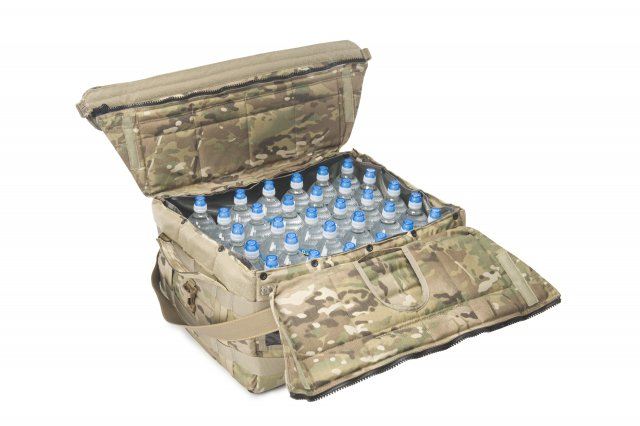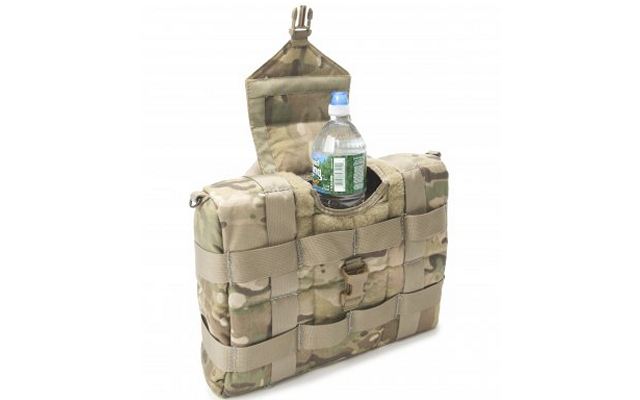| a | |||
Combat cooler for armoured vehicle |
|||
| Friday, May 2, 2014 01:33 PM | |||
| United States Army to develop insulated bottled water containers for soldiers in the battlefield. | |||
Researchers
from the U.S. Army Natick Soldier Research, Development and Engineering
Center responded to the Joint Program Office for Mine-Resistant, Ambush-Protected
vehicles with a container to not only insulate and protect the water bottle,
but also make bottled water easy to reach and cool enough for Soldiers
to want to consume it. |
|||
 Large version of NSRDEC's new Insulated Container for Bottled Water, holding 36 water bottles |
|||
| |
|||
| United
States Army researchers answered the call for insulated bottled water
containers for Soldiers in the field. The result may be a life-saving
product to protect Soldiers in vehicles during combat missions when water
bottles could become dangerous projectiles during explosions. "We came up with initial prototypes that were large, medium and individual with minimal funding using the project manager's concept and Combat Feeding's concept, so we just fabricated it," said Laurra Winters, team leader for the Aerial Delivery Design and Fabrication Team, Aerial Delivery Directorate. Through their work on systems that have to survive intense airdrops, Winters' team has developed the skills and equipment necessary to handle creating a prototype with blast survivability for water bottles and rations, which will most often be Meals-Ready-to-Eat, or MREs. Initial concepts for the system included a zipper that went around the storage bag. Unfortunately, zippers tend to fail, and if the zipper breaks, the bag will no longer keep water cool and protected. "You need some level of redundancy with this system because if one fails, then the system is no good," Winters said. The final prototypes utilize webbing wrapped around the bag to encase the material instead of relying on a zipper, or seams, to hold the bag together. The webbing has a minimum breaking strength of 6,000 pounds, which provides the necessary strength to the overall system to successfully retain all contents. "Your weakest link is going to be your closure and your seam, so by reinforcing it with the webbing, you are improving the strength and the performance of it," Winters said. "We also put in hook and loop, too, just so that there is some level of redundancy if the closure system fails." |
|||
 The small individual version of NSRDEC's new Insulated Container for Bottled Water |
|||
The
large system holds 36 water bottles, or 28 MREs. The medium bag holds
15 water bottles, or six MREs, and the small individual bag holds five
water bottles. NSRDEC is working with the Tank Automotive Research, Development
and Engineering Center's Occupant Centric Protection, or OCP, on integrating
the ICBs into the next generation of vehicles. User evaluation testing
and blast testing should occur this year.
"We've done drop testing, vibration testing, flammability testing, performance testing at the Doriot Climactic Chambers, and abrasion testing," said Ben Williams, ICB project officer on the CFD Systems Equipment and Engineering team. "We also linked up with Johns Hopkins University's Applied Physics Lab to conduct in-vehicle blast testing, because our customer's number one requirement was that these bags needed to be blast-proof in an [improvised explosive device] scenario." Containing the bottles within the bag ensures that they do not become projectiles that could harm Soldiers. Keeping water palatable is the other concern. "The temperature of the water is a big factor when keeping the Soldiers hydrated," Williams said. "We've done lots of studies on what water temperatures are most palatable for Soldiers. Soldiers drink more water when it's cold and remain hydrated for longer periods of time because they are consuming more water. This improves Soldier endurance. We consider it a force multiplier." Temperatures in areas of operation can reach 95 to 120 degrees Fahrenheit on average in the summer months, creating an even greater demand for cool water as Soldiers exert themselves every day. Drinking water, safely contained and cool, is often taken for granted by many in the U.S. For Soldiers serving abroad, however, it is an extremely valuable commodity. |
|||
United States Army to develop insulated bottled water containers for soldiers in the battlefield 020
- Posted On














